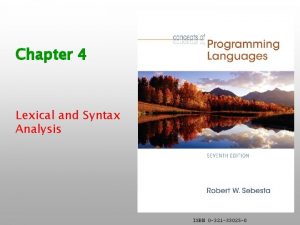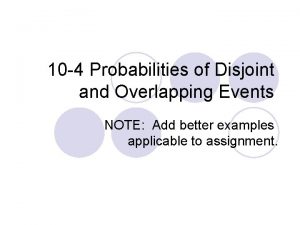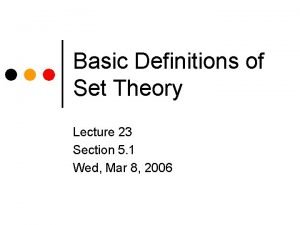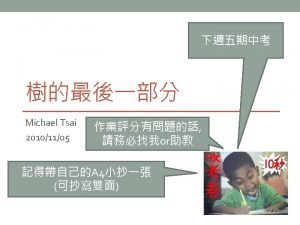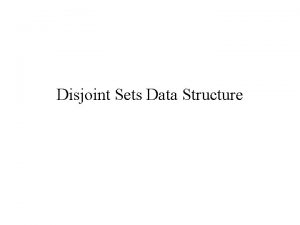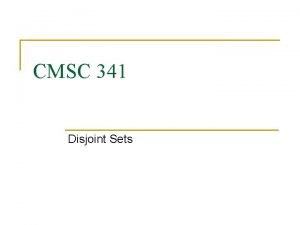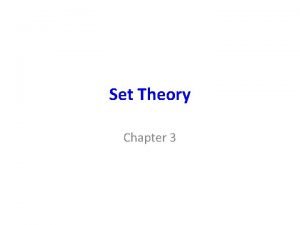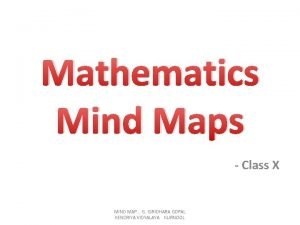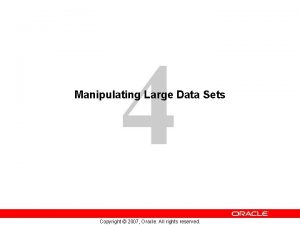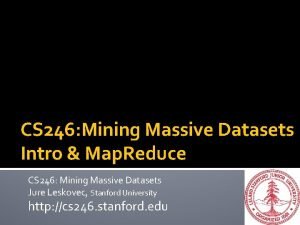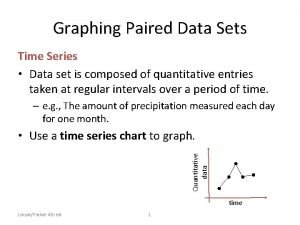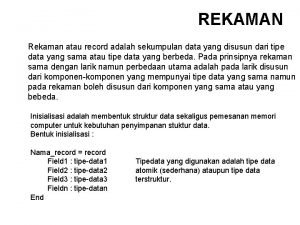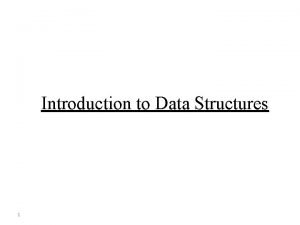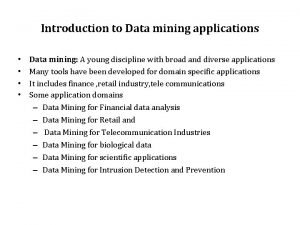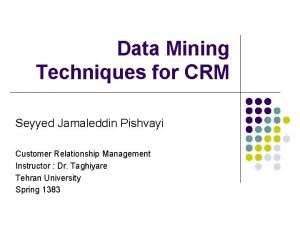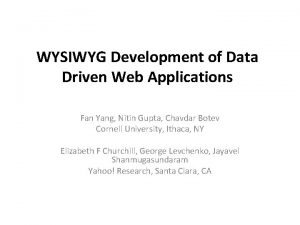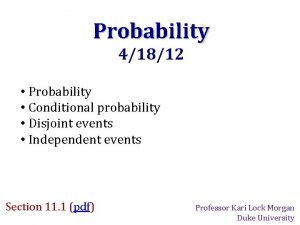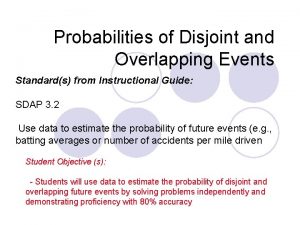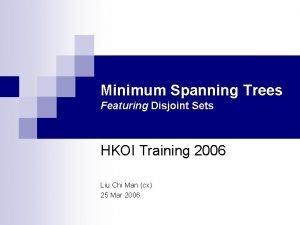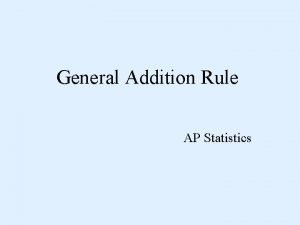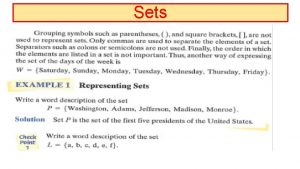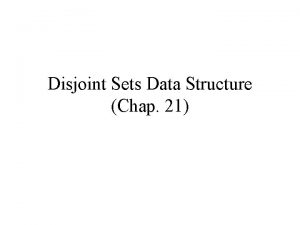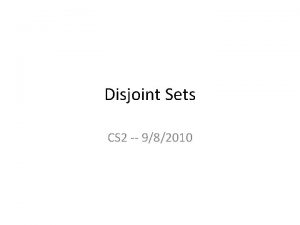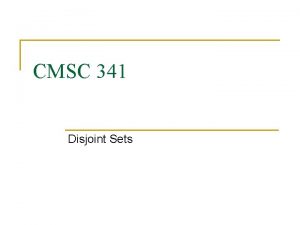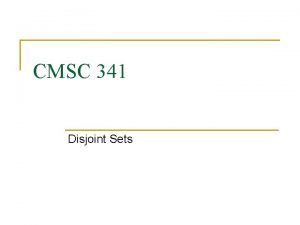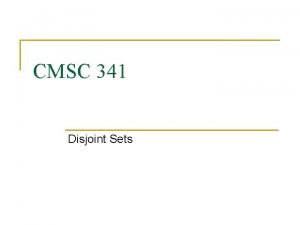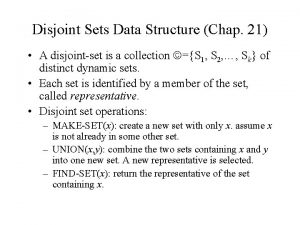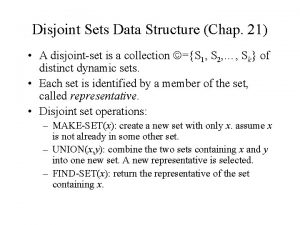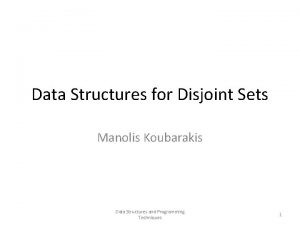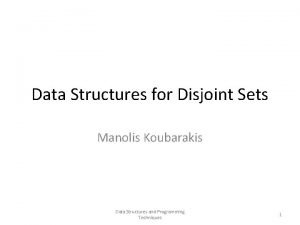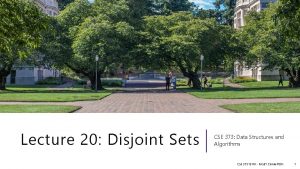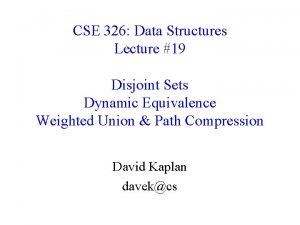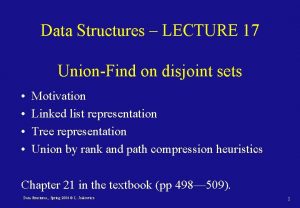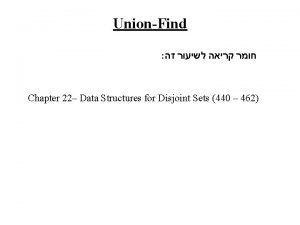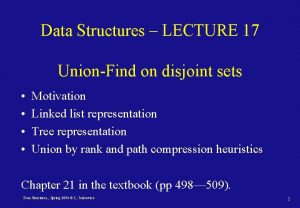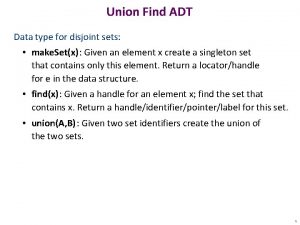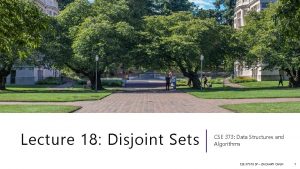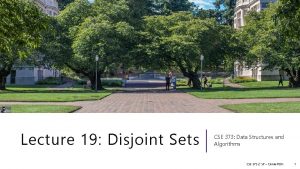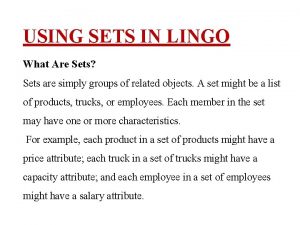Disjoint Sets Data Structure Disjoint Sets Some applications






![Connected Components CONNECTED_COMPONENTS(G) for each vertex v in V[G] do MAKE_SET (v) for each Connected Components CONNECTED_COMPONENTS(G) for each vertex v in V[G] do MAKE_SET (v) for each](https://slidetodoc.com/presentation_image/39bc2d502fc6f546a55f5cb00714e6ff/image-7.jpg)



















![Find Set • FIND_SET(d) if d != p[d]= FIND_SET(p[d]) return p[d] c a b Find Set • FIND_SET(d) if d != p[d]= FIND_SET(p[d]) return p[d] c a b](https://slidetodoc.com/presentation_image/39bc2d502fc6f546a55f5cb00714e6ff/image-27.jpg)










- Slides: 37

Disjoint Sets Data Structure

Disjoint Sets • Some applications require maintaining a collection of disjoint sets. • A Disjoint set S is a collection of sets where • Each set has a representative which is a member of the set (Usually the minimum if the elements are comparable)

Disjoint Set Operations • Make-Set(x) – Creates a new set where x is it’s only element (and therefore it is the representative of the set). O(1) time. • Union(x, y) – Replaces by one of the elements of becomes the representative of the new set. O(log n) time. • Find(x) – Returns the representative of the set containing x O(log n) time

Analyzing Operations • We usually analyze a sequence of m operations, of which n of them are Make_Set operations, and m is the total of Make_Set, Find, and Union operations • Each union operations decreases the number of sets in the data structure, so there can not be more than n-1 Union operations

Applications • Equivalence Relations (e. g Connected Components) • Minimal Spanning Trees

Connected Components • Given a graph G we first preprocess G to maintain a set of connected components. CONNECTED_COMPONENTS(G) • Later a series of queries can be executed to check if two vertexes are part of the same connected component SAME_COMPONENT(U, V)
![Connected Components CONNECTEDCOMPONENTSG for each vertex v in VG do MAKESET v for each Connected Components CONNECTED_COMPONENTS(G) for each vertex v in V[G] do MAKE_SET (v) for each](https://slidetodoc.com/presentation_image/39bc2d502fc6f546a55f5cb00714e6ff/image-7.jpg)
Connected Components CONNECTED_COMPONENTS(G) for each vertex v in V[G] do MAKE_SET (v) for each edge (u, v) in E[G] do if FIND_SET(u) != FIND_SET(v) then UNION(u, v)

Connected Components SAME_COMPONENT(u, v) return FIND_SET(u) ==FIND_SET(v)

Example e g f h j i a b c d

(b, d) e g f h j i a b c d

(e, g) e g f h j i a b c d

(a, c) e g f h j i a b c d

(h, i) e g f h j i a b c d

(a, b) e g f h j i a b c d

(e, f) e g f h j i a b c d

(b, c) e g f h j i a b c d

Result e g f h j i a b c d

Connected Components • During the execution of CONNECTEDCOMPONENTS on a undirected graph G = (V, E) with k connected components, how many time is FIND-SET called? How many times is UNION called? Express you answers in terms of |V|, |E|, and k.

Solution • FIND-SET is called 2|E| times. FIND-SET is called twice on line 4, which is executed once for each edge in E[G]. • UNION is called |V| - k times. Lines 1 and 2 create |V| disjoint sets. Each UNION operation decreases the number of disjoint sets by one. At the end there are k disjoint sets, so UNION is called |V| - k times.

Linked List implementation • We maintain a set of linked list, each list corresponds to a single set. • All elements of the set point to the first element which is the representative • A pointer to the tail is maintained so elements are inserted at the end of the list a b c d

Union with linked lists

Analysis • Using linked list, MAKE_SET and FIND_SET are constant operations, however UNION requires to update the representative for at least all the elements of one set, and therefore is linear in worst case time • A series of m operations could take

Analysis • Let n be the number of make set operations, then a series of n MAKE_SET operations, followed by q-1 UNION operations will take since • q, n are an order of m, so in total we get which is an amortized cost of m for each operations

Improvement – Weighted Union • Always append the shortest list to the longest list. A series of operations will now cost only • MAKE_SET and FIND_SET are constant time and there are m operations. • For Union, a set will not change it’s representative more than log(n) times. So each element can be updated no more than log(n) time, resulting in nlogn for all union operations

Disjoint-Set Forests • Maintain A collection of trees, each element points to it’s parent. The root of each tree is the representative of the set • We use two strategies for improving running time – Union by Rank c – Path Compression a b d f

Make Set • MAKE_SET(x) p(x)=x rank(x)=0 x
![Find Set FINDSETd if d pd FINDSETpd return pd c a b Find Set • FIND_SET(d) if d != p[d]= FIND_SET(p[d]) return p[d] c a b](https://slidetodoc.com/presentation_image/39bc2d502fc6f546a55f5cb00714e6ff/image-27.jpg)
Find Set • FIND_SET(d) if d != p[d]= FIND_SET(p[d]) return p[d] c a b d f

Union w c • UNION(x, y) x a link(find. Set(x), find. Set(y)) b • link(x, y) if rank(x)>rank(y) then p(y)=x else p(x)=y if rank(x)=rank(y) then rank(y)++ f y d z c a b d w f x y z

Analysis • In Union we attach a smaller tree to the larger tree, results in logarithmic depth. • Path compression cause a very deep tree to become very shallow • Combining both ideas gives us (without proof) a sequence of m operations in

Exercise • Describe a data structure that supports the following operations: – find(x) – returns the representative of x – union(x, y) – unifies the groups of x and y – min(x) – returns the minimal element in the group of x

Solution • We modify the disjoint set data structure so that we keep a reference to the minimal element in the group representative. • The find operation does not change (log(n)) • The union operation is similar to the original union operation, and the minimal element is the smallest between the minimal of the two groups

Example • Executing find(5) 7 1 4 4 4 1 3 1 2 3 4 5 6. . N Parent 4 7 4 4 7 6 min 1 6 6 7 2 5

Example • Executing union(4, 6) 4 1 3 1 2 3 4 5 6. . N Parent 4 7 4 min 1 1 6 7 2 5

Exercise • Describe a data structure that supports the following operations: – find(x) – returns the representative of x – union(x, y) – unifies the groups of x and y – de. Union() – undo the last union operation

Solution • We modify the disjoint set data structure by adding a stack, that keeps the pairs of representatives that were last merged in the union operations • The find operations stays the same, but we can not use path compression since we don’t want to change the modify the structure after union operations

Solution • The union operation is a regular operation and involves an addition push (x, y) to the stack • The de. Union operation is as follows – (x, y) s. pop() – parent(x) x – parent(y) y

Example • Example why we can not use path compression. – Union (8, 4) – Find(2) – Find(6) – De. Union() 1 2 3 4 5 6 7 8 9 10 parent 4 7 7 4 8 1 5 8 1 4
 Pairwise disjoint test
Pairwise disjoint test Disjoint event probability
Disjoint event probability Mutually disjoint sets example
Mutually disjoint sets example Mutually disjoint sets example
Mutually disjoint sets example Linked list representation of disjoint sets
Linked list representation of disjoint sets Disjoint set data structure
Disjoint set data structure Disjoint maze
Disjoint maze Roster notation example
Roster notation example Image sets
Image sets Stack is a static data structure
Stack is a static data structure Linear equations in two variables class 10 mind map
Linear equations in two variables class 10 mind map Sometimes you win some
Sometimes you win some God when you choose to leave mountains unmovable
God when you choose to leave mountains unmovable Ice cream uncountable
Ice cream uncountable Force and motion
Force and motion Some say the world will end in fire some say in ice
Some say the world will end in fire some say in ice Some say the world will end in fire some say in ice
Some say the world will end in fire some say in ice Some trust in chariots and some in horses song
Some trust in chariots and some in horses song Manipulating large data sets
Manipulating large data sets Mining massive datasets
Mining massive datasets Divide data sets in fourths
Divide data sets in fourths Paired data set
Paired data set Sekumpulan data
Sekumpulan data Data structure operations
Data structure operations Sap systems applications and products
Sap systems applications and products System application and product in data processing
System application and product in data processing Spatial data mining applications
Spatial data mining applications Building data mining applications for crm
Building data mining applications for crm Characteristics of big data applications
Characteristics of big data applications Data driven web applications
Data driven web applications Novel data science applications
Novel data science applications Er diagram disjoint
Er diagram disjoint Phomosexual
Phomosexual Overlapping probability examples
Overlapping probability examples What is path compression
What is path compression Pronoms personnels conjoints
Pronoms personnels conjoints General addition rule for two events
General addition rule for two events Disjoint maze
Disjoint maze
